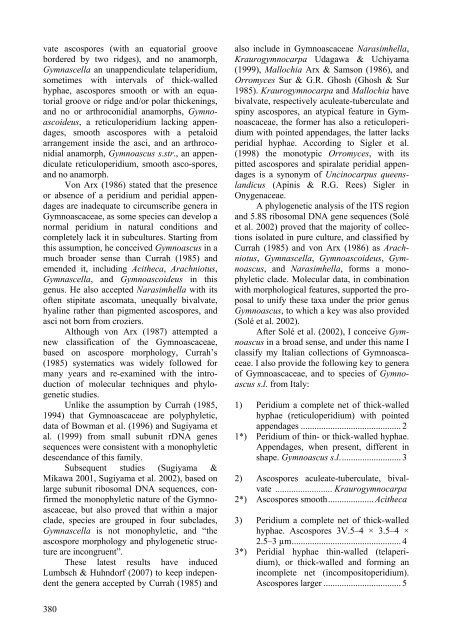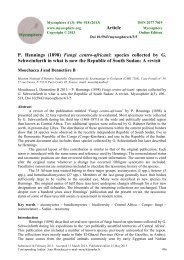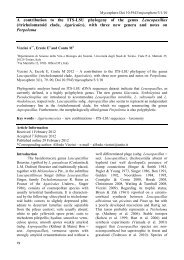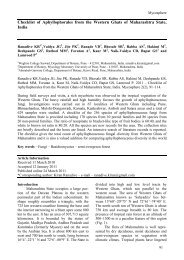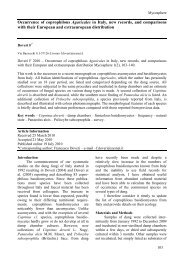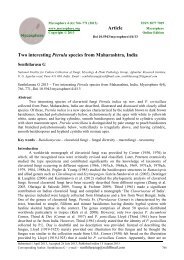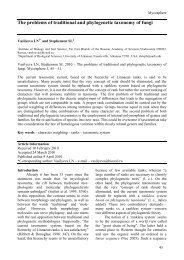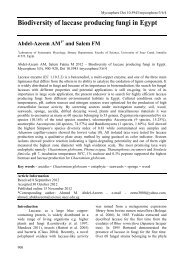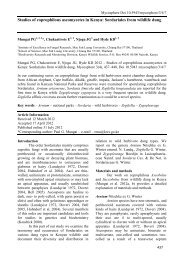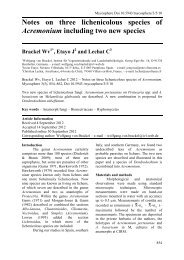Fungi Fimicoli Italici - Mycosphere-online journal
Fungi Fimicoli Italici - Mycosphere-online journal
Fungi Fimicoli Italici - Mycosphere-online journal
Create successful ePaper yourself
Turn your PDF publications into a flip-book with our unique Google optimized e-Paper software.
vate ascospores (with an equatorial groove<br />
bordered by two ridges), and no anamorph,<br />
Gymnascella an unappendiculate telaperidium,<br />
sometimes with intervals of thick-walled<br />
hyphae, ascospores smooth or with an equatorial<br />
groove or ridge and/or polar thickenings,<br />
and no or arthroconidial anamorphs, Gymnoascoideus,<br />
a reticuloperidium lacking appendages,<br />
smooth ascospores with a petaloid<br />
arrangement inside the asci, and an arthroconidial<br />
anamorph, Gymnoascus s.str., an appendiculate<br />
reticuloperidium, smooth asco-spores,<br />
and no anamorph.<br />
Von Arx (1986) stated that the presence<br />
or absence of a peridium and peridial appendages<br />
are inadequate to circumscribe genera in<br />
Gymnoascaceae, as some species can develop a<br />
normal peridium in natural conditions and<br />
completely lack it in subcultures. Starting from<br />
this assumption, he conceived Gymnoascus in a<br />
much broader sense than Currah (1985) and<br />
emended it, including Acitheca, Arachniotus,<br />
Gymnascella, and Gymnoascoideus in this<br />
genus. He also accepted Narasimhella with its<br />
often stipitate ascomata, unequally bivalvate,<br />
hyaline rather than pigmented ascospores, and<br />
asci not born from croziers.<br />
Although von Arx (1987) attempted a<br />
new classification of the Gymnoascaceae,<br />
based on ascospore morphology, Currah’s<br />
(1985) systematics was widely followed for<br />
many years and re-examined with the introduction<br />
of molecular techniques and phylogenetic<br />
studies.<br />
Unlike the assumption by Currah (1985,<br />
1994) that Gymnoascaceae are polyphyletic,<br />
data of Bowman et al. (1996) and Sugiyama et<br />
al. (1999) from small subunit rDNA genes<br />
sequences were consistent with a monophyletic<br />
descendance of this family.<br />
Subsequent studies (Sugiyama &<br />
Mikawa 2001, Sugiyama et al. 2002), based on<br />
large subunit ribosomal DNA sequences, confirmed<br />
the monophyletic nature of the Gymnoascaceae,<br />
but also proved that within a major<br />
clade, species are grouped in four subclades,<br />
Gymnascella is not monophyletic, and “the<br />
ascospore morphology and phylogenetic structure<br />
are incongruent”.<br />
These latest results have induced<br />
Lumbsch & Huhndorf (2007) to keep independent<br />
the genera accepted by Currah (1985) and<br />
380<br />
also include in Gymnoascaceae Narasimhella,<br />
Kraurogymnocarpa Udagawa & Uchiyama<br />
(1999), Mallochia Arx & Samson (1986), and<br />
Orromyces Sur & G.R. Ghosh (Ghosh & Sur<br />
1985). Kraurogymnocarpa and Mallochia have<br />
bivalvate, respectively aculeate-tuberculate and<br />
spiny ascospores, an atypical feature in Gymnoascaceae,<br />
the former has also a reticuloperidium<br />
with pointed appendages, the latter lacks<br />
peridial hyphae. According to Sigler et al.<br />
(1998) the monotypic Orromyces, with its<br />
pitted ascospores and spiralate peridial appendages<br />
is a synonym of Uncinocarpus queenslandicus<br />
(Apinis & R.G. Rees) Sigler in<br />
Onygenaceae.<br />
A phylogenetic analysis of the ITS region<br />
and 5.8S ribosomal DNA gene sequences (Solé<br />
et al. 2002) proved that the majority of collections<br />
isolated in pure culture, and classified by<br />
Currah (1985) and von Arx (1986) as Arachniotus,<br />
Gymnascella, Gymnoascoideus, Gymnoascus,<br />
and Narasimhella, forms a monophyletic<br />
clade. Molecular data, in combination<br />
with morphological features, supported the proposal<br />
to unify these taxa under the prior genus<br />
Gymnoascus, to which a key was also provided<br />
(Solé et al. 2002).<br />
After Solé et al. (2002), I conceive Gymnoascus<br />
in a broad sense, and under this name I<br />
classify my Italian collections of Gymnoascaceae.<br />
I also provide the following key to genera<br />
of Gymnoascaceae, and to species of Gymnoascus<br />
s.l. from Italy:<br />
1) Peridium a complete net of thick-walled<br />
hyphae (reticuloperidium) with pointed<br />
appendages ............................................ 2<br />
1*) Peridium of thin- or thick-walled hyphae.<br />
Appendages, when present, different in<br />
shape. Gymnoascus s.l. .......................... 3<br />
2) Ascospores aculeate-tuberculate, bivalvate<br />
......................... Kraurogymnocarpa<br />
2*) Ascospores smooth .................... Acitheca<br />
3) Peridium a complete net of thick-walled<br />
hyphae. Ascospores 3V.5–4 × 3.5–4 ×<br />
2.5–3 µm ................................................ 4<br />
3*) Peridial hyphae thin-walled (telaperidium),<br />
or thick-walled and forming an<br />
incomplete net (incompositoperidium).<br />
Ascospores larger .................................. 5


